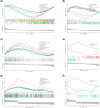ERCC5, HES6 and RORA are potential diagnostic markers of coronary artery disease
- PMID: 35934844
- PMCID: PMC9527589
- DOI: 10.1002/2211-5463.13469
ERCC5, HES6 and RORA are potential diagnostic markers of coronary artery disease
Abstract
The mortality rate of patients with coronary artery disease (CAD) increases year by year, and the age of onset is decreasing, primarily because of the lack of an efficient and convenient diagnostic method for CAD. In the present study, we aimed to detect CAD-correlated biomarkers and the regulatory pathways involved through weighted co-expression network analysis. The microarray data originated from 93 CAD patients and 48 controls within the Gene Expression Omnibus (GEO) database. The gene network was implemented by weighted gene co-expression network analysis, and the genes were observed to fall into a range of modules. We took the intersection of genes in the modules most correlated with CAD with the differentially expressed genes of CAD, which were identified by applying the limma package. Lasso regression and support vector machine recursive feature elimination algorithms were used to determine CAD candidate signature genes. The biomarkers for diagnosing CAD were detected by validating candidate signature gene diagnostic capabilities (receiver operating characteristic curves) based on data sets from GEO. Three modules were selected, and 26 vital genes were identified. Eight of these genes were reported as the optimal candidate features in terms of CAD diagnosis. Through receiver operating characteristic curve analysis, we identified three genes (ERCC5, HES6 and RORA; area under the curve > 0.8) capable of distinguishing CAD from the control, and observed that these genes are correlated with the immune response. In summary, ERCC5, HES6 and RORA may have potential for diagnosis of CAD.
Keywords: ERCC5; HES6; RORA; bioinformatics; coronary heart disease; diagnostic marker.
© 2022 The Authors. FEBS Open Bio published by John Wiley & Sons Ltd on behalf of Federation of European Biochemical Societies.
Conflict of interest statement
The authors declare that they have no conflicts of interest.
Figures










Similar articles
-
Identification of potential M2 macrophage-associated diagnostic biomarkers in coronary artery disease.Biosci Rep. 2022 Dec 22;42(12):BSR20221394. doi: 10.1042/BSR20221394. Biosci Rep. 2022. PMID: 36222281 Free PMC article.
-
Construction of genetic classification model for coronary atherosclerosis heart disease using three machine learning methods.BMC Cardiovasc Disord. 2022 Feb 12;22(1):42. doi: 10.1186/s12872-022-02481-4. BMC Cardiovasc Disord. 2022. PMID: 35151267 Free PMC article.
-
Identification and validation of diagnostic biomarkers of coronary artery disease progression in type 1 diabetes via integrated computational and bioinformatics strategies.Comput Biol Med. 2023 Jun;159:106940. doi: 10.1016/j.compbiomed.2023.106940. Epub 2023 Apr 15. Comput Biol Med. 2023. PMID: 37075605
-
Coronary artery disease associated specific modules and feature genes revealed by integrative methods of WGCNA, MetaDE and machine learning.Gene. 2019 Aug 20;710:122-130. doi: 10.1016/j.gene.2019.05.010. Epub 2019 May 7. Gene. 2019. PMID: 31075415
-
NCF2, MYO1F, S1PR4, and FCN1 as potential noninvasive diagnostic biomarkers in patients with obstructive coronary artery: A weighted gene co-expression network analysis.J Cell Biochem. 2019 Oct;120(10):18219-18235. doi: 10.1002/jcb.29128. Epub 2019 Jun 27. J Cell Biochem. 2019. PMID: 31245869 Free PMC article.
Cited by
-
Comprehensive Multi-omics Mapping of Vesicle Cargo from Plasma or Novel Tissue Vesicles Reveals Pathological Changes in Cargo with Patient Age.bioRxiv [Preprint]. 2025 Jul 28:2024.12.06.627231. doi: 10.1101/2024.12.06.627231. bioRxiv. 2025. PMID: 39713371 Free PMC article. Preprint.
-
Fine Mapping Identifies Candidate Genes Associated with Swine Inflammation and Necrosis Syndrome.Vet Sci. 2025 May 21;12(5):508. doi: 10.3390/vetsci12050508. Vet Sci. 2025. PMID: 40431601 Free PMC article.
-
Integrated Bioinformatics Analysis and Experimental Verification of Immune Cell Infiltration and the Related Core Genes in Ulcerative Colitis.Pharmgenomics Pers Med. 2023 Jun 23;16:629-643. doi: 10.2147/PGPM.S406644. eCollection 2023. Pharmgenomics Pers Med. 2023. PMID: 37383675 Free PMC article.
References
-
- Shao C, Wang J, Tian J, Tang Y‐D. Coronary artery disease: from mechanism to clinical practice. In: Wang M, editor. Coronary artery disease: therapeutics and drug discovery. Singapore: Springer Singapore; 2020. p. 1–36. - PubMed
-
- Shimada K. Immune system and atherosclerotic disease heterogeneity of leukocyte subsets participating in the pathogenesis of atherosclerosis. Circ Res. 2009;73:994–1001. - PubMed
MeSH terms
Substances
LinkOut - more resources
Full Text Sources
Medical
Molecular Biology Databases
Miscellaneous

